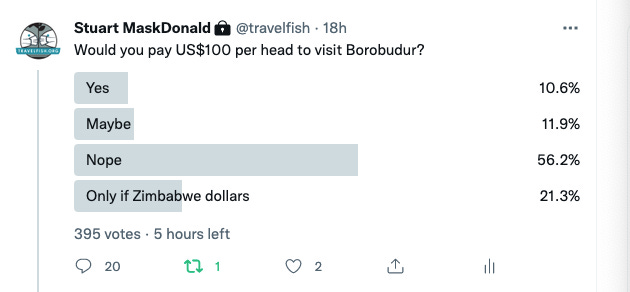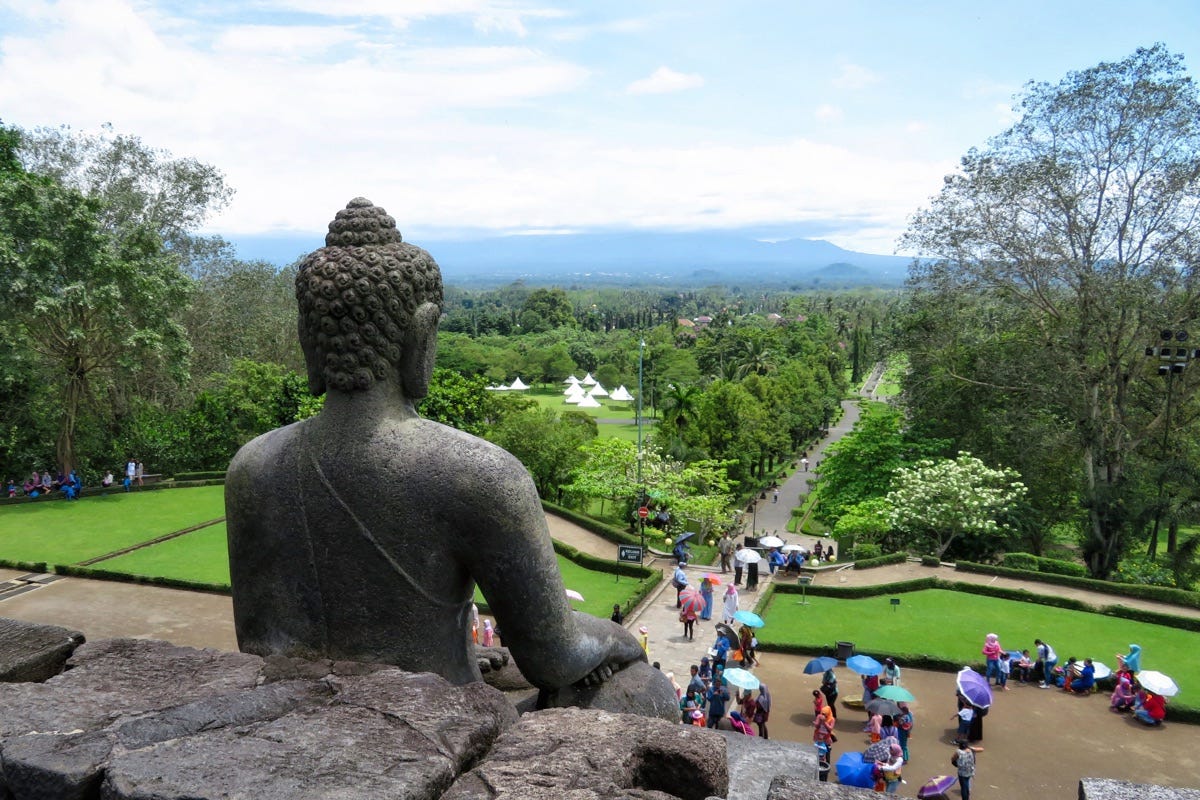On Saturday, Indonesia’s Coordinating Minister for Maritime Affairs and Investment took to Instagram. This in itself isn’t unusual—many government departments and ministers here are active on the platform. What he had to say though, was a little out of the left field.
The Minister announced his decision to limit the number of tourists visiting Borobudur to 1,200 per day. Alongside the revised visitor numbers he announced new admission tariffs. Indonesians would pay 750,000 rupiah (with students remaining at 5,000 rupiah). Foreigners would pay US$100. In the past, Indonesians paid 50,000 rupiah and foreigners paid US$25. The increases, fifteen-fold and four-fold respectively, are significant. As a reference point, 750,000 rupiah is roughly half of the monthly minimum wage in many cities in Indonesia. Seems like a lot to pay to see your own cultural heritage? Sure is.
Something is going up in smoke. Photo: Sally Arnold.
A later announcement noted that the old ticket would remain on offer, though I think only for Indonesians. If you wanted to climb to the summit—what you could do on the old ticket—you would need to buy the new pricey ticket.
If you’ve never heard of Borobudur, I’ll pass the baton for a moment to Travelfish writer Sally Arnold, who, after describing Borobudur as “One of the world’s greatest treasures,” goes on to write:
“Under the shadow of temperamental Gunung Merapi, one of Indonesia’s most active volcanoes, the ancient Buddhist monument Borobudur emerges majestically from the surrounding jungle and farmland.
On first impressions, the rather squat grey mass of volcanic stone that makes up Borobudur may not seem as impressive as other towering structures—the temple has no chambers you can enter. Instead, the massive complex envelops a small hill, which when viewed from above follows the form of a giant mandala.
The lower, almost-square-shaped base stretches approximately 120 metres each side, topped by six concentric square terraces decorated with 2,672 exquisitely carved relief panels and 504 Buddha sculptures, leading to an upper trio of circular-shaped levels topped with 72 bell-like stupas, culminating with a large dome at the centre. [Ed: Sally, that sentence is too long!] By walking the ancient pilgrims’ path, roughly five kilometres clockwise around each level, past the lower galleries with images of “desire,” to the levels of the teachings and life of Buddha, and finally to the realm of “nothingness”, you can appreciate the sheer splendour of this antiquity, the world’s largest Buddhist monument.”
Sally, never one to hold back, has another two thousand-odd words on the site here. Go on and read it. I’ll wait.
You will meet people. Photo: Sally Arnold.
It is, particularly at dawn, with Merapi smoking in the distance and the vast mist-draped savannah-like forest to the side, an undeniably exquisite site. Across the region, Borobudur is in the same class as Angkor and Bagan, yet to many, its diminutive size lends itself to scale comparisons with somewhere like Wat Phu in southern Laos. And while you can take the five-kilometre stroll as described by Sally above, most don’t. And here lies the rub—the site is popular, very popular.
In 1974 Borobudur saw around 260,000 visitors. By the mid-1990s that had risen ten-fold to about 2.5 million. Thanks to the Asian Crisis of 1997 and 1998, followed by a challenging domestic period, growth slowed. By 2013 visitors were over three million, over 90% of whom were domestic travellers. In 2018, on the cusp of the pandemic, 3,663,054* domestic and 192,231* international tourists visited. Almost four million people or over 10,000 per day.
* Important Note: These figures marked with * are sourced from a paper using data from Magelang Regency (home to Borobudur). The thesis I mention (PDF) elsewhere has figures almost twice as high but had no verifiable source. Regardless, there are loads of people in a restricted amount of real estate.
It is very big in a small kind of a way. Photo: Sally Arnold.
Most of those four million were not taking Sally’s five-kilometre route. Instead, they were climbing the stairs at the east side of the temple—the quickest way to the top. In this interesting thesis, the author notes that calculations done by Balai Konservasi Borobudur (Indonesian language only) noted that for every two million tourists, there were 0.2 millimetres of wear and tear (on the stairs I assume—rather than the entire monument!) That might not sound like much, but when you’ve got six million tourists per year it accumulates fast.
This brings us, I guess to the Instagram announcement on Saturday. Antara reported:
“He [Minister Luhut] said that the step has been carried out solely for the sake of preserving the historical and cultural wealth of the country.”
Regular Indonesia-watchers will be aware this is far from the first time tourism policy has appeared somewhat impromptu. Like when Komodo was going to be $1,000 a head as the latest step towards Indonesia’s drive for “high-quality tourists”—something it has been talking about since the 1970s. It’s the classic hammer nail solution that one sees right around the planet. “Too many tourists? Let’s put the prices up—that’ll fix it.”
Locals waiting for the arrival of digital nomads. Photo: Sally Arnold.
The prices will undoubtedly see a reduction in visitor numbers. After I saw the news, I added a poll on Twitter asking if people would pay US$100 per head to visit Borobudur. Almost 22% of people (395 have voted as I type this) said they’d only pay that much if it was one hundred Zimbabwe dollars. This was a greater number than the total number who said yes or maybe. In fact, it pretty much mirrors the drop in numbers (from 10,000 to 1,200) the Minister is after.
There’s a whole raft of reasons why this might not be the right idea. Doubly so with a marque site like Borobudur, and holds particularly true with foreign tourists on organised tours. To a point the site and the city it is most often visited from—Yogyakarta—anchors the entire Java experience. I gave Mark Ord, founder and CEO of All Points East (and an old friend) a call.
Can’t link because my account is private. Twitter so frustrating sometimes.
It turned out he hadn’t heard the news—which raises concerns about how much outreach or research goes into decisions like this—he should follow Indonesian ministers on Instagram I guess. I asked him if he thought the increase in prices would see them drop Yogyakarta from their Java tours. His reply was instructive:
“Don’t think you could reconsider Yogya without reconsidering Java! It’s the most tourist-friendly town, and Borobudur is the highlight. The government has got you by the short and curlies.”
You can’t do a tour of Java and not visit Borobudur. Therefore you have to pay.
Chillin, waiting for the other 9,923 people to arrive for the day. Photo: Sally Arnold.
I wonder, stepping away from organised tours if independent travellers will feel the same way. For those with the funds, those who have already spent thousands to get here, and for whom Indonesia is but a whimsy of luxurious (and often foreign-owned) resorts, spas, and hotels—why not?
Others not so much. The obvious calculus will be “Is Borobudur more than twice as good as Angkor (where one-day admission is US$37)?” The answer, at least in my humble opinion, as magnificent as Borobudur might be, is a resounding no. But why is Indonesia forcing me to ask myself this stupid question?
The authorities would be well-advised to look into some of their neighbour’s plans. Where destinations have multi-day passes which work out as far better value and encourage multiple visits—Borobudur is worth at least two. Best of all, hopefully, a longer stay in Yogyakarta—to the benefit of all the people involved in tourism services there—and better for tourists too, who will have time to better appreciate a fascinating city. Yes, you now have time to visit the Chicken Church! Instead, this policy seems to want people to stay for as short a time as possible. Why?
Of course, you must visit here. Photo: Sally Arnold.
The thing is, looking at the numbers, foreigners are but a rounding error. So I had a chat with Trinity, an Indonesian travel writer, who kicked off her travelling fame with The Naked Traveller series. Emphatic that the price is too high, she noted the action may well protect Borobudur but will kill tourism in the process. As Trinity sees it, the essence of Borobudur are the stories on the reliefs, and to see those, one needs the pricier ticket.
When I ask her about alternative ways to protect the monument, the suggestions come thick and fast. Organised time slots to better manage visitors and mandated online ticket purchases. Tighter regulations, more guards and stricter staff. In conclusion, she notes a maximum price of 250,000 rupiah seems palatable, but with that should come transparency—where exactly is all this money going?
Amen.
I don’t think anyone who has visited the site in the last decade wouldn’t admit that people management is an issue. That the situation has been bad for so long, makes this weekend’s announcement all the more depressing. Why? Because there are far more equitable approaches to this problem and it isn’t like people haven’t had time to consider different options.
Damn this is a beautiful country. Photo: Sally Arnold.
While I’m not trying to tell anyone how to do their job, if they were looking for alternatives, they could consider any of the following. Limit ticketing thus requiring booking in advance. Restricting large groups to certain less popular times of the day. Setting aside a small portion of the tickets for sale on the day—first come first served. Encourage more people to take Sally’s stroll rather than zooming straight to the top. Install wooden walkways to protect the monument in areas of wear and tear. Perhaps also listen to the dudes that granted the heritage listing in the first place—that’d be UNESCO, who do seem to be banging their heads on their desks and are “seriously concerned”.
There are pros and cons to each of these, and some would have more challenges to put in place than others. All are more difficult than simply jacking up the price. These are all though, far fairer approaches than simply stating one of the world’s greatest treasures, and a highlight of Indonesia is now largely for the wealthy alone.
What would Buddha think?
Couchfish is 100 per cent independent and reader-supported. If you’re not already a subscriber, and you’d like to show your support, become a paying subscriber today for just US$7 per month—you can find out more about Couchfish here—or simply share this story with a friend.
Don’t forget, you can find the free podcasts on Apple, Pocket Casts and Spotify as well as right here on Couchfish.


















